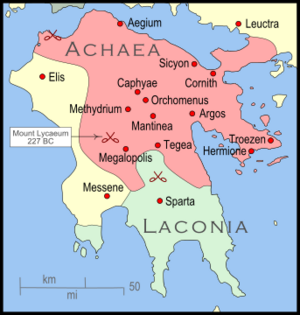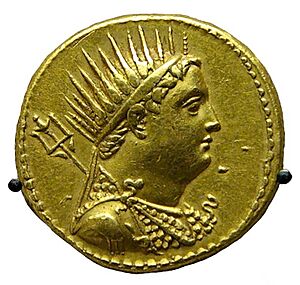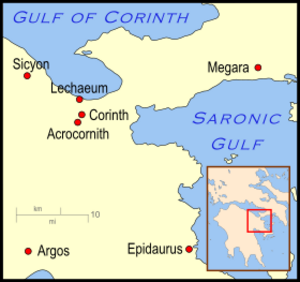Cleomenean War facts for kids
Quick facts for kids Cleomenean War |
|||||||||
|---|---|---|---|---|---|---|---|---|---|
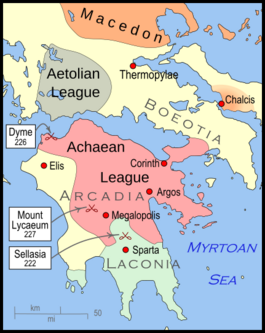 Greece during the Cleomenean War |
|||||||||
|
|||||||||
| Belligerents | |||||||||
| Sparta, Elis |
Achaean League, Macedonia |
||||||||
| Commanders and leaders | |||||||||
| Cleomenes III | Aratus, Antigonus III Doson |
||||||||
| Strength | |||||||||
| ~20,000 (at largest muster) | ~30,000 (at largest muster) | ||||||||
The Cleomenean War (229/228–222 BC) was a big fight between Sparta and the Achaean League. They were battling for control of the Peloponnese, which is a large peninsula in southern Greece.
At first, under their king Cleomenes III, Sparta was winning. This made the Achaean League ask for help from the Macedonian king Antigonos Doson. He came and defeated Cleomenes in a major battle called the Battle of Sellasia in 222 BC.
In 235 BC, Cleomenes III became king of Sparta. He wanted to bring back Sparta's old traditions and make the city strong again. He also wanted to reduce the power of the ephors. These were elected officials who had become very powerful in Sparta.
In 229 BC, the ephors sent Cleomenes to take a town near Megalopolis. The Achaean League saw this as an act of war. Cleomenes fought back by attacking the Achaean region. He defeated their army twice, once at Mount Lycaeum and again near Megalopolis.
Cleomenes quickly took over cities in Arcadia that had Achaean soldiers. He then won another big battle at Dyme. The Achaean League was worried about Sparta becoming too powerful. So, their leader, Aratus of Sicyon, decided to ask Antigonus III Doson of Macedon for help. In return for this help, the Achaeans had to give Antigonus control of the fortress overlooking Corinth.
Cleomenes later attacked Achaea, taking control of Corinth and Argos. But when Antigonus arrived in the Peloponnese, Cleomenes had to go back to Laconia, Sparta's home region. The final battle happened at Sellasia, where the Spartans lost badly. Cleomenes then escaped to Egypt, where he later died after a failed uprising.
Contents
Why the War Started
Cleomenes III became king of Sparta in 235 BC. He took the throne from his father, Leonidas II. Before Cleomenes became king, there had been a lot of fighting between the two royal families in Sparta.
In 229 BC, Cleomenes took over important cities like Tegea, Mantineia, Caphyae, and Orchomenus in Arcadia. These cities had joined forces with the Aetolian League, which was a strong group of Greek city states. Some historians say Cleomenes took these cities by trickery. Others say the cities asked him for help.
Later that year, the ephors sent Cleomenes to take a place called Athenaeum, near Belbina. Belbina was an important entrance to Laconia, and Sparta and Megalopolis were arguing over it. Because of this, the Achaean League decided to declare war on Sparta. Cleomenes made his position stronger in response.
Aratus of Sicyon, the leader of the Achaean League, tried to take back Tegea and Orchomenus in a surprise night attack. But his plan failed, and he quietly left. Cleomenes found out about the attack and sent a message to Aratus, asking why he had come. Aratus replied that he wanted to stop Cleomenes from building up Belbina. Cleomenes then cleverly asked, "If it's all the same to you, write and tell me why you brought along those torches and ladders."
Early Battles and Spartan Wins
After making Belbina stronger, Cleomenes marched into Arcadia with 3,000 infantry (foot soldiers) and some cavalry (soldiers on horseback). But the ephors called him back to Sparta. This gave Aratus a chance to capture Caphyae. When Cleomenes heard this, the ephors sent him out again. He managed to capture the city of Methydrium and then attacked the area around Argos.
Around this time, the Achaean League sent a new army to fight Cleomenes. This army had 20,000 foot soldiers and 1,000 cavalry. They marched towards Cleomenes' smaller army of 5,000 Spartans at Pallantium. Aratus, who was with the Achaean army, told their leader to retreat. He believed that even 20,000 Achaeans could not beat 5,000 Spartans. So, the Achaean army pulled back.
Meanwhile, Ptolemy III of Egypt had been helping the Achaean League with money. But he decided to switch his support to Sparta. Ptolemy thought that a strong Sparta would be a better friend against Macedon than a struggling Achaean League.
In May 227 BC, Aratus was again chosen as the Achaean leader. He attacked Elis. The people of Elis asked Sparta for help. As the Achaeans were returning from Elis, Cleomenes attacked them near Mount Lycaeum and completely defeated their army. Aratus then used a rumor that he had been killed to surprise and capture Mantinea.
Around this time, the other king of Sparta, Eudamidas III, died. Cleomenes wanted to make his position stronger against the ephors, who didn't like his plans to expand Sparta's power. So, he called his uncle Archidamus V back from exile to become the new king. But Archidamus was killed soon after he returned to Sparta.
Battle of Ladoceia and Changes in Sparta
Later in 227 BC, Cleomenes paid the ephors to let him continue his war against the Achaeans. He then marched into the area of Megalopolis and captured a village called Leuctra. An Achaean army arrived and fought the Spartans, pushing them back a little. Cleomenes had to retreat across some difficult land.
Aratus told his Achaean soldiers not to chase the Spartans. But Lydiadas of Megalopolis ignored the order and charged with his cavalry. Cleomenes used the difficult ground to his advantage. He sent his soldiers from Crete and Tarentum to attack Lydiadas's cavalry. They defeated the cavalry, and Lydiadas was killed. This made the Spartans feel brave, and they attacked the main Achaean army, defeating them completely. The Achaeans were very upset and lost hope because Aratus had not supported Lydiadas. They didn't attack again that year.
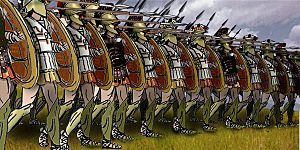
Cleomenes now felt very strong. He started planning against the ephors. He convinced his stepfather that they needed to get rid of the ephors. He said they could then share the ephors' property with all citizens and make Sparta the most powerful city in Greece. With his stepfather's help, Cleomenes began his revolution.
He captured Heraea and Asea. He also brought food to the people of Orchomenus, who were being attacked by the Achaeans. This made his opponents tired, and they asked to rest in Arcadia. Cleomenes then marched to Sparta with his hired soldiers. He sent his loyal followers to kill the ephors. Four of the five ephors were killed. The last one, Agylaeus, escaped to a temple.
With the ephors gone, Cleomenes started his changes. First, he gave his own land to the state. His stepfather and friends followed, and then other citizens did too. He divided all the Spartan land equally among the citizens. He also made more people citizens, including some perioeci, who were like a middle class in Sparta but didn't have full citizenship.
Having more citizens meant Cleomenes could build a bigger army. He trained 4,000 hoplites (heavy foot soldiers) and brought back Sparta's old military training. He also made his army stronger by using the Macedonian sarissa (a very long spear). Cleomenes finished his changes by making his brother, Eucleidas, the other king of Sparta.
Sparta Takes Control of the Peloponnese
Ptolemy III of Egypt offered to keep helping Cleomenes with money. But he had one condition: Cleomenes had to send his mother and children to Egypt as hostages. Cleomenes wasn't sure, but his mother agreed to go to Egypt when she heard about Ptolemy's offer.
In 226 BC, the people of Mantinea asked Cleomenes to remove the Achaean soldiers from their city. One night, Cleomenes and his troops secretly entered the city and removed the Achaean soldiers. Then they marched to nearby Tegea. From Tegea, the Spartans went into Achaea. Cleomenes hoped to force the Achaean League to fight him in a big battle.
Cleomenes marched his army to Dyme. There, he met the entire Achaean army. In the Battle of Dyme, the Spartans completely defeated the Achaean phalanx (a group of soldiers in a tight formation). Many Achaeans were killed or captured. After this win, Cleomenes captured the city of Lasium and gave it to the people of Elis.
The Achaeans were very discouraged after this battle. Aratus refused to be their general anymore. When both Athens and the Aetolian League refused to help them, the Achaeans asked Cleomenes for peace. At first, Cleomenes asked for small things. But as talks continued, his demands grew. He eventually insisted that he should become the leader of the Achaean League. In return, he would give back the prisoners and strongholds he had taken.
The Achaeans invited Cleomenes to Lerna for a meeting. On his way there, Cleomenes drank too much water. This made him lose his voice and cough up blood. He had to go back to Sparta.
Aratus used this chance to plan against Cleomenes with King Antigonus III Doson of Macedon. Earlier, in 227 BC, Megalopolis had sent people to Macedon to ask for help. But Antigonus wasn't very interested then. Aratus wanted the Macedonian king to come to the Peloponnese and defeat Cleomenes. But Antigonus asked for control of Acrocorinth (a fortress) in return. The Achaean League didn't want to give up Acrocorinth, so they didn't ask Macedon for help at that time.
When the Achaeans met in Argos, Cleomenes came to meet them. However, Aratus, who had now made a deal with Antigonus, demanded that Cleomenes give 300 hostages to the Achaeans and enter the city alone, or come with all his soldiers. When Cleomenes heard this, he said he had been treated unfairly and declared war on the Achaeans again.
Achaea was now in chaos, and some cities were close to rebelling. Many people were angry that Aratus had invited the Macedonians into the Peloponnese. Some also hoped that Cleomenes would bring changes to their cities. Cleomenes took advantage of this. He attacked Achaea and captured the cities of Pellene, Pheneus, and Penteleium. This split the Achaean League in half.
The Achaeans were worried about people in Corinth and Sicyon secretly supporting Sparta. They sent their hired soldiers to guard these cities. Then they went to Argos to celebrate the Nemean Games.
Cleomenes thought Argos would be easier to capture while it was full of people for the festival. This would cause panic. During the night, he took control of the high ground above the city's theater. The people of the city were too scared to fight back. They accepted Spartan soldiers, gave twenty hostages to Cleomenes, and became Sparta's friends. Capturing Argos made Cleomenes very famous. No Spartan king had ever managed to take Argos before. Even Pyrrhus of Epirus, a famous general, had died trying to take the city.
Soon after Argos was captured, Cleonae and Phlius also surrendered to Cleomenes. Meanwhile, Aratus was in Corinth, looking for people who supported Sparta. When he heard what happened at Argos, Aratus expected Corinth to fall to Sparta. He called a meeting, and with all the citizens present, he quickly rode his horse and escaped to Sicyon. The Corinthians did surrender their city to Cleomenes. Cleomenes sent his stepfather, Megistonous, to Aratus. He asked Aratus to give up Acrocorinth, the fortress of Corinth, in return for a lot of money.
Quickly, Hermione, Troezen, and Epidaurus surrendered to Cleomenes. He went from Argos to Corinth and started attacking the fortress. He sent a message to Aratus, suggesting that Acrocorinth should be guarded by both Spartans and Achaeans. He also offered Aratus a large payment. Aratus had a difficult choice: give the city to Antigonus or let it fall to Cleomenes. He chose to make a deal with Antigonus and sent his son to Macedon as a hostage. Cleomenes then attacked the area of Sicyon and trapped Aratus inside the city for three months. Aratus eventually escaped to attend an Achaean meeting.
Macedonian Help Arrives
Antigonus arrived with a large army of 20,000 foot soldiers and 1,300 cavalry. He was marching through Euboea towards the Peloponnese. The Aetolian League, who were not friendly, had said they would fight him if he went further south than Thermopylae. Aratus met Antigonus and was convinced to give the city of Megara to Boeotia.
When Cleomenes heard that the Macedonians were coming, he stopped attacking Sicyon. He built a trench and a fence from Acrocorinth to the Isthmus. He chose this spot to avoid fighting the Macedonian phalanx head-on.
Antigonus tried many times to break through Cleomenes' defenses, but he failed and lost many soldiers. These defeats made Antigonus think about giving up his attack. However, Aratus was visited by friends from Argos who invited Antigonus to their city. The people of Argos were ready to revolt because Cleomenes had not made any changes in their city. Antigonus sent 1,500 men with Aratus to sail to Epidaurus and then march to Argos. At the same time, the Achaean general, Timoxenos, marched with more men from Sicyon. When the Achaean soldiers arrived, the whole city of Argos, except for the fortress, was in the hands of the Argives.
When Cleomenes heard about the revolt in Argos, he sent his stepfather with 2,000 men to help. But Megistonous was killed while attacking the city. The Spartan soldiers in the fortress were left to fight alone. Cleomenes then left his strong position at the Isthmus because he was afraid of being surrounded. Corinth then fell to Antigonus. Cleomenes marched his troops to Argos and fought his way into the city, rescuing the men stuck in the fortress. He then retreated to Mantinea when he saw Antigonus's army nearby.
After going back to Arcadia and hearing about his wife's death, Cleomenes returned to Sparta. This allowed Antigonus to march through Arcadia and take the towns Cleomenes had made stronger, including Athenaeum, which he gave to Megalopolis. Antigonus continued to Aegium, where the Achaeans were holding their meeting. He reported on his actions and was made the main commander of all the allied forces.
Antigonus used this chance to bring back the Hellenic League, which had been started by Philip II of Macedon. Most Greek city-states joined this league. These included Macedon, Achaea, Boeotia, Thessaly, Phocis, Locris, Acarnania, Euboea, and Epiros. Some historians believe that for Antigonus, this League was just a way to make Macedon more powerful.
In early 223 BC, Antigonus marched to Tegea. The Achaeans joined him there, and together they attacked the city. The people of Tegea held out for a few days, but they were forced to surrender because of the Macedonians' siege weapons. After taking Tegea, Antigonus went to Laconia, where Cleomenes' army was waiting. But when his scouts reported that the soldiers from Orchomenus were marching to meet Cleomenes, Antigonus quickly moved his army. This surprised Orchomenus and forced it to surrender. Antigonus then captured Mantinea, Heraea, and Telphusa, which trapped Cleomenes in Laconia. Antigonus then went back to Aegium, gave another report, and sent his Macedonian soldiers home for the winter.
Cleomenes got money for his hired soldiers from Ptolemy. Antigonus seems to have given some land in Asia Minor to Ptolemy. In return, Ptolemy stopped giving money to Sparta. This left Cleomenes without money to pay his soldiers. Desperate, Cleomenes freed all helots (Spartan slaves) who could pay a certain amount of silver. This way, he got a lot of money. He also armed 2,000 of these freed helots in the Macedonian style to fight against the Macedonian elite troops. Then he planned a big attack.
The Fall of Megalopolis
Cleomenes noticed that Antigonus had sent his Macedonian soldiers home and was only traveling with his hired soldiers. At that time, Antigonus was in Aegium, a three-day march from Megalopolis. Most of the Achaean men who could fight had been killed in earlier battles.
Cleomenes ordered his army to take five days' worth of food. He sent his troops towards Sellasia, pretending to attack the area of Argos. From there, he went to the territory of Megalopolis. During the night, he told one of his friends, Panteus, to capture the weakest part of the city walls. Cleomenes and the rest of the army followed. Panteus managed to take that part of the wall after killing the guards. This allowed Cleomenes and the Spartan army to enter the city.
When dawn came, the people of Megalopolis realized the Spartans were in the city. Some ran away, while others stayed and fought. Cleomenes had more soldiers, which forced the defenders to retreat. But their fighting allowed most of the people to escape. Only about 1,000 were captured. Cleomenes sent a message to Messene, where the people who had escaped had gathered. He offered to give them back their city if they became his friends. The people of Megalopolis refused. In return, the Spartans destroyed the city and burned it to the ground. Cleomenes managed to get a lot of valuable items from the city.
The Battle of Sellasia
The destruction of Megalopolis shocked the Achaean League. Cleomenes then went with his army to attack the area of Argos. He knew that Antigonus would not fight him because Antigonus didn't have enough soldiers. Cleomenes also hoped that his attack would make the people of Argos lose faith in Antigonus because he couldn't protect their land. One historian said this attack was "an impressive show, but it only made it clearer that Cleomenes had to be defeated in a big battle."
In the summer of 222 BC, Antigonus called his soldiers from Macedon. They arrived along with other allied forces. The Macedonian army had about 10,000 Macedonian foot soldiers (most with long spears), 3,000 light-armed soldiers, 1,200 cavalry, 3,000 hired soldiers, 8,600 Greek allies, and 3,000 Achaean foot soldiers. This made a total of about 29,200 men.
Cleomenes had made all the passes into Laconia strong with barriers and trenches. Then he went with his army of 20,000 men to the pass at Sellasia, on the northern border of Laconia. Overlooking the pass were two hills, Evas and Olympus. Cleomenes placed his brother, Eucleidas, with the allied troops and the Perioeci on Evas. Cleomenes himself stayed on Olympus with 6,000 Spartan hoplites and 5,000 hired soldiers.
When Antigonus reached Sellasia with his army, he saw that it was well-guarded. He decided not to attack the strong position right away. Instead, he set up camp near Sellasia and waited for several days. During this time, he sent scouts to check out the area and pretend to attack Cleomenes's position.
Since he couldn't force Cleomenes to move, Antigonus decided to risk a big battle. He placed some of his Macedonian foot soldiers and Illyrians facing the Evas hill in a special formation. The Epirots, the Acarnanians, and 2,000 Achaean foot soldiers stood behind them as backup. The cavalry took a position opposite Cleomenes's cavalry, with 1,000 Achaean and Megalopolitan foot soldiers ready to help. Antigonus himself stood opposite Cleomenes with the rest of his Macedonian foot soldiers and hired soldiers.
The battle began when the Illyrian troops on the Macedonian right side attacked the Spartan force on Evas. The Spartan light-armed soldiers and cavalry noticed that the Achaean foot soldiers were not protected from behind. They quickly attacked the back of the Macedonian right side and almost broke their line. However, at that important moment, Philopoemon of Megalopolis (who later became a great Achaean hero) tried to warn the cavalry commanders about the danger. When they didn't listen, Philopoemon gathered a few other cavalrymen and charged the Spartan cavalry. The Spartans who were attacking from behind stopped fighting the enemy. This made the Macedonians brave enough to charge at the Spartan positions. The Spartans' left side was eventually pushed back and forced off the hill, and their commander, Eucleidas, was killed. They ran away from the battle.
Meanwhile, the Macedonian phalanx on the left side fought the Spartan phalanx and hired soldiers. At the start, the Macedonian phalanx gave up some ground. But then their heavy weight pushed back the Spartan phalanx. The Spartans were overwhelmed by the deeper lines of the Macedonian phalanx and were defeated. Cleomenes managed to escape with a small group of men. The battle was very costly for the Spartans; only 200 of the 6,000 Spartans who fought survived.
What Happened Next
After losing at Sellasia, Cleomenes went back to Sparta for a short time. He told the citizens to accept Antigonus's terms. Under the cover of darkness, he escaped from Sparta with some friends. He went to the city's port of Gythium and got on a ship heading to Egypt.
Antigonus entered Sparta in victory. He was the first foreign conqueror of Sparta. However, he treated the people kindly. He ordered that Cleomenes's changes be undone, and he brought back the ephors. But he did not force Sparta to join his League. One historian thinks that Antigonus's failure to bring back the Spartan kings means that this return to old laws was not real. Within three days, Antigonus left Sparta and went back to Macedon to deal with an invasion. He left soldiers in Acrocorinth and Orchomenos. After Cleomenes's defeat, Sparta's power fell apart, and it was ruled by different tyrants (harsh rulers).
When Cleomenes arrived in Alexandria, Ptolemy welcomed him with smiles and promises. At first, Ptolemy was careful around Cleomenes, but he soon respected him. He promised to send Cleomenes back to Greece with an army and ships. He also promised to give Cleomenes money every year. However, before he could keep his promise, Ptolemy died. With his death, Cleomenes's hope of returning to Greece ended, because the new king, the weak Ptolemy IV, took the throne.
Ptolemy IV started to ignore Cleomenes. Soon, his chief minister, Sosibius, had Cleomenes put under house arrest. This happened after Cleomenes was falsely accused of planning against the king. In 219 BC, Cleomenes and his friends escaped from house arrest. They ran through the streets of Alexandria, trying to start a rebellion against Ptolemy. When this failed, Cleomenes and all his friends took their own lives.


